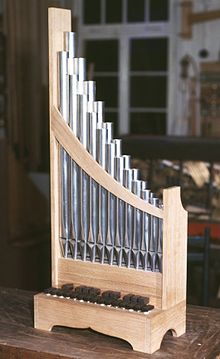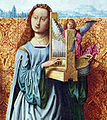Portative

The portative (from the Latin portare "to carry"; Italian. Organetto ("Örgelchen")) belongs to the smallest [pipe] organs next to the shelf .
Construction, sound and playing style
In contrast to the shelf, which has tongue whistles , the portative is only equipped with lip whistles . In many portatives, the pipes are made in fixed scale , that is, all pipes have the same diameter, which results in a sound that changes slightly over the range.
The portative differs from the larger pipe organ types, including the positive organ , in its smaller pitch range, which barely exceeds two octaves , and the lack of the ability to change timbre. The hand-held bellows allow the sound and volume of the pipes to be varied by directly influencing the wind pressure. Some portatives are equipped with additional drone pipes that can be switched on individually and sound deeper than the melody pipes and are therefore usually designed as covered pipes for reasons of space .
A major difference to all other types of organs, including the shelf, is the position of the keyboard in relation to the player. The latter places the portable while sitting on his lap, stands it on his bent thigh or carries it on a strap over his shoulder. He operates the keyboard exclusively with his right hand, while with his left he operates the bellows or the bellows that feed wind to the pipes. In comparison to all other types of organs, the player (portatifer) is not directly in front of the keyboard, but at a right angle to it.
The external appearance of the portable is always asymmetrical. The pipes are arranged diatonic or (later) in the sequence of the chromatic scale and are as close as possible to the respective key of the keyboard on the wind chest . The game mechanics are therefore simply designed: Each key opens the game valve of the pipe above.
Historical classification
The portative is a historical musical instrument that was mainly played in the Middle Ages and in Renaissance music. It was used less and less in baroque music . Although the portative is depicted as a musical instrument played by angels on many works of painting and the visual arts, it was rarely used in church music . Most of the portative players were minstrels .
Since the reintroduction of the classic wind chest system, the mechanical sliding chest , in the 1930s, the portative has been built more frequently again, as a journeyman's piece by organ builders, who demonstrate all the essential craftsmanship of their profession on this small instrument, which is much cheaper to manufacture compared to the large organ can.
As a modern variant of the portative, the pitch-adjustable portative has been available since 2002, which has a tuning device for each individual pipe. It is mainly used in music education and is used to learn clean intonation and to understand historical tuning systems .
Portative in the organ museum Borgentreich (replica)
Representation of an angel with a portative in the Himmelkron monastery
See also
literature
- Hans Hickmann: The portative. A contribution to the history of the small organ. Bärenreiter, Kassel 1972, ISBN 3-7618-0400-8 (repr. Of the Kassel edition 1936).
- Adrian Wehlte: Ear training, from Pythagoras to well-tempered. How a converted portative can support intonation training. New music newspaper 11/2009



